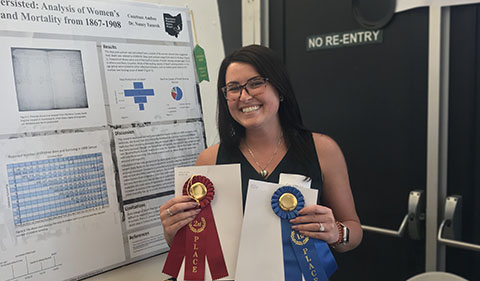
Courtnee Ambos ’19
Honors Tutorial College Biological Sciences student Courtnee Ambos ’19 took a first and a second at the Ohio University Student Research & Creative Expo.
Her presentation, “Nevertheless She Persisted: Analysis of Women’s Health and Mortality from 1867-1908,” won first place in the Appalachian Rural Health Institute session and second place in the Sociology & Anthropology session.
This wasn’t her first time participating in the Expo, which she describes as “always a great time.” Ambos sees supporting all the various research projects on campus as a very important aspect of her learning experience and personal growth as a young scholar.
The best part of her project, she says, was collecting the data and researching, and being able to present to judges who were genuinely interested in her work was “really rewarding.”
She credits her mentor and co-researcher, Dr. Nancy Tatarek, Associate Professor of Anthropology, as key to her success. “She was always there to help me through things I was stuck on and really helped me develop my ideas into this project!” explains Ambos.
Ambos’ award winning-project examined women aged 15 to 50 years of age in Athens and Perry counties and their mortality following child birth. She used Ohio county death registers, as well as the U.S. Census Bureau to collect the data.
Her research found that, overall, as women had more children their risk of dying increased along with child mortality. There were some really interesting cases where women had large numbers of children and the majority of them survived as well. Women at the time of her study had drastically different reproductive outcomes.
Ambos landed in this area of research while looking through a list of apprenticeships available through the Honors Tutorial College.
“I was not initially interested in working in a lab, so this project seemed like the perfect fit for me,” she explains. “I was able to apply my biological knowledge in many ways throughout the process and it was really fun to see the two disciplines come together.”



















Comments